Main menu
Common skin conditions

NEWS
Join DermNet PRO
Read more
Quick links
Non-sexually acquired human papillomavirus infection — extra information
Non-sexually acquired human papillomavirus infection
Author: Umaima Khatoon, 5th Year Medical Student, University of Auckland, Auckland, New Zealand. Medical Editor: Dr Helen Gordon, Auckland, New Zealand. DermNet Editor in Chief: Adjunct A/Prof Amanda Oakley, Dermatologist, Hamilton, New Zealand. 2019. Revised September 2020. Copy edited by Gus Mitchell.
Introduction Demographics Causes Clinical features Complications Diagnosis Differential diagnoses Treatment Outcome
What is a non-sexually acquired human papillomavirus infection?
Human papillomavirus (HPV) is a small double-stranded DNA virus which has been classified into over 200 types based on genome sequencing. Each type is associated with infection at a particular anatomic site and clinical morphology.
HPV infections can be sexually transmitted or non-sexually acquired; this review focuses on the latter.
Transmission of non-sexually acquired HPV occurs when infected skin or skin squames are in direct contact with broken or macerated skin.
Who gets non-sexually acquired human papillomavirus infections?
Non-sexually acquired human papillomavirus infection is common in:
- Children and young adults
- Workers who handle meat, poultry, and fish — the so-called ‘butcher warts’ due to HPV 7.
Extensive and persistent HPV infection is seen in association with:
- Immunosuppression, such as acquired immunodeficiency virus (HIV) infection with acquired immune deficiency syndrome (AIDS), and organ transplant recipients on long-term immunosuppressive drugs.
- Atopic dermatitis.
What causes a non-sexually acquired human papillomavirus infection?
Cutaneous infection is mostly associated with HPV types 1, 2, 3, 4, 7, and 10, which cause common, flat, and plantar warts.
Non-sexually acquired HPV with the HPV types above can occasionally affect the skin of the anogenital region. Examples of transmission include:
- Autoinoculation from a viral wart elsewhere on the body, typically from a child's hand
- Inoculation from the hand of a caregiver during a nappy change
- Vertical transmission from mother to baby during vaginal delivery.
What are the clinical features of non-sexually acquired human papillomavirus infection?
HPV infection of the skin can present with a clinical lesion ie, wart. Subclinical infection or latent infection is normal-appearing HPV-infected skin. The incubation period can be as long as 12 months, as demonstrated by the eruption of viral warts a year after an organ transplant, or in early experiments injecting wart tissue to demonstrate infectivity.
The clinical manifestations of non-sexually acquired HPV are classified according to the anatomical site and lesion morphology. Warts may be solitary or multiple, and when multiple are often clustered or in lines due to autoinoculation.
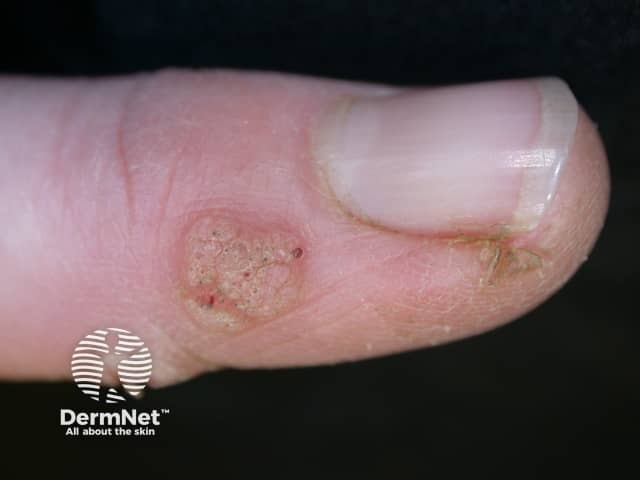
Verruca vulgaris on a thumb
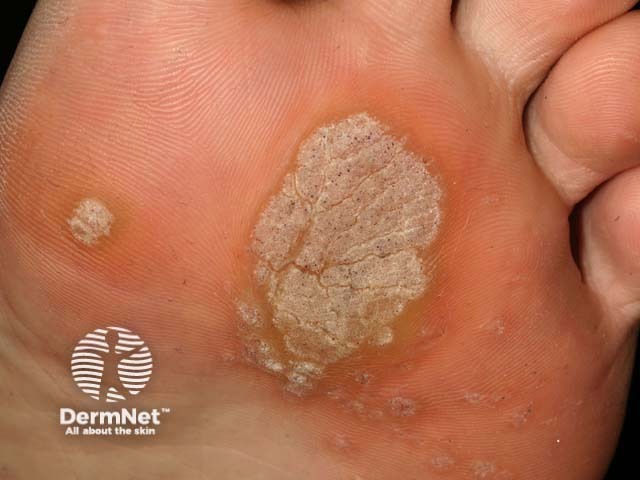
Plantar warts
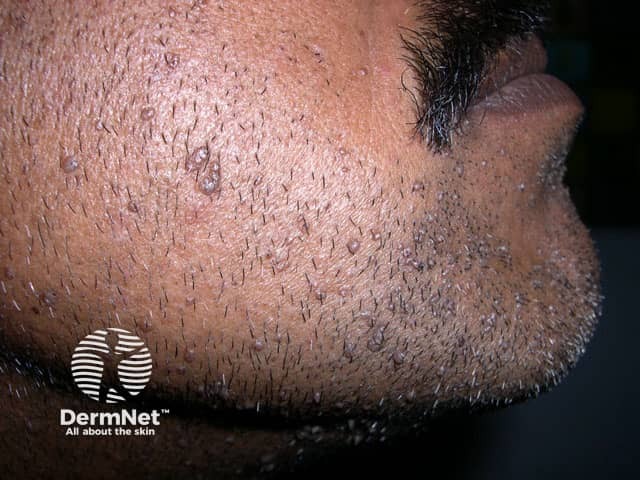
Verruca plana in the beard area spread by shaving
Warts
- Common viral warts (verruca vulgaris) affect keratinised skin, especially hands, feet, and knees. They are dome-shaped, circumscribed, hyperkeratotic and verrucous papules and nodules. The majority of common warts are asymptomatic, but are easily traumatised causing pain.
- Plantar warts (verruca plantaris) affect the soles of the feet. A plantar wart presents as a thickening with loss of surface skin lines (dermatoglyphics) in contrast to accentuated dermatoglyphics through a corn. On paring down, multiple pinpoint bleeding spots of patent papillary capillaries or black dots of thrombosed capillaries are encountered. Capillaries are not seen on paring corns. Plantar warts are especially tender with lateral pressure rather than with direct pressure typical of corns. Plantar warts can occur anywhere on the sole; corns occur only at pressure sites.
- Mosaic warts are a field of warts, especially seen on the soles of sweaty feet.
- Flat warts (verruca plana) are small < 5 mm flat-topped skin-coloured papules seen particularly on the face where they are spread by shaving.
- Subungual and periungual warts can affect the nail plate. Warts under the free edge of a nail probably result from picking or scratching a wart elsewhere.
- Filiform warts have a narrow base and fine elevated keratotic fronds. They are typically seen on the face.
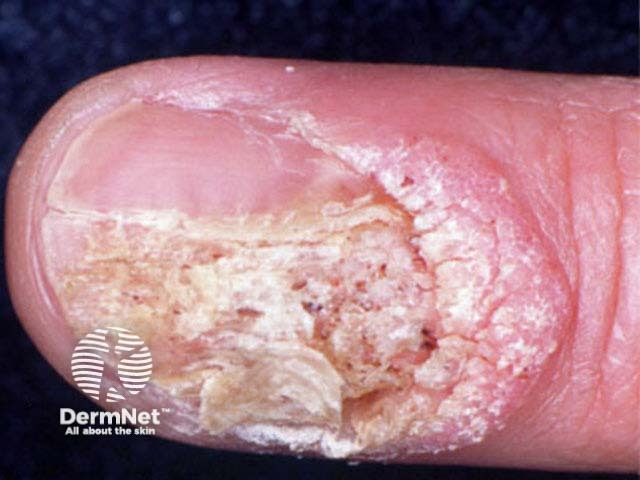
Ungual wart
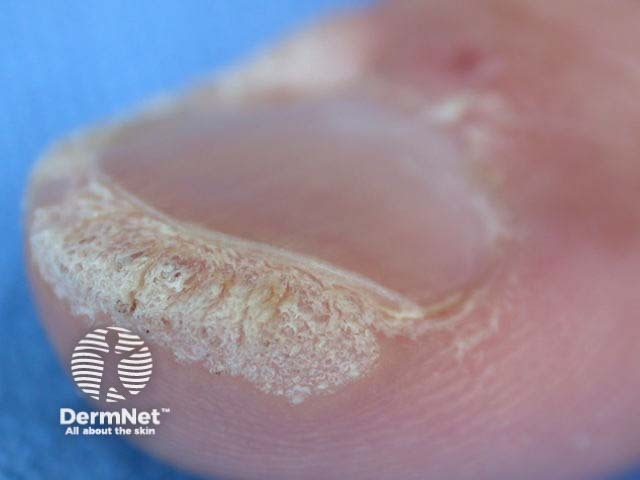
Subungual wart

Filiform wart
Epidermodysplasia verruciformis
Epidermodysplasia verruciformis is a rare autosomal recessive disorder with an increased susceptibility to specific HPV types, most commonly types 5 and 8. It results in the early onset of disseminated flat polymorphic lesions resembling pityriasis versicolor or plane warts.
Epidermodysplasia verruciformis carries an increased risk of HPV-related cutaneous squamous cell carcinoma (SCC). Immunosuppressed patients with HIV infection or are post-transplant may very rarely present with multiple HPV lesions resembling epidermodysplasia verruciformis.
What are the complications of non-sexually acquired human papillomavirus infection?
Non-sexually acquired HPV may cause:
- Cosmetic concern
- Discomfort, especially from plantar warts on pressure sites
- Social consequences such as teasing at school or exclusion from sport
- Spread to other body sites, particularly with immunosuppression or atopic dermatitis
- Malignant transformation in epidermodysplasia verruciformis.
How is a non-sexually acquired human papillomavirus infection diagnosed?
HPV-related warts are usually diagnosed on examination.
- Dermoscopy may reveal rounded keratinous structures with patent or thrombosed capillaries appearing as red or black dots respectively.
- A skin biopsy may be required, such as in an organ transplant recipient with a keratotic lesion suspicious for SCC. Warts show characteristic features on histology. See verruca vulgaris pathology and verruca plana pathology.
What is the differential diagnosis for non-sexually acquired human papillomavirus infections?
Non-sexually acquired human papillomavirus lesions may appear similar to:
What is the treatment for non-sexually acquired human papillomavirus infection?
Treatment of the cutaneous manifestations of HPV infections can be challenging. A wait and see approach can be appropriate in children who are likely to see warts resolve spontaneously.
Many treatments have been suggested for cutaneous warts, and most lack adequate clinical trials demonstrating efficacy.
First line treatments are various over-the-counter wart paints and pastes containing salicylic acid, podophyllin, and other ingredients. Higher concentrations of paints may be applied by a dermatologist.
Cryotherapy with liquid nitrogen is the most commonly used treatment by doctors. This needs to be applied multiple times at frequent intervals soon after the surface layer has peeled off and before the wart has a chance to regrow. However, to be effective, cryotherapy is painful and should induce a blister. Cryotherapy with carbon dioxide snow was mostly ineffective for warts and 'spray cans' wart treatments only achieve a similar temperature.
Other treatments used off-label include:
- Imiquimod cream
- Contact immunotherapy
- Intralesional bleomycin.
Treatment should include a rim of normal-looking skin where the virus has probably already spread. Horseshoe-shaped and ring-shaped recurrences around treatment sites are common.
HPV is infectious, so common-sense measures are required to minimise spread.
- Avoid deliberate unnecessary handling of warts on self or others.
- Do not share a tool used on a wart such as nail file.
- Avoid shaving hair-bearing skin where there are warts especially on the beard area.
- Wear footwear in communal places such as public showers.
What is the outcome for non-sexually acquired human papillomavirus infection?
Cutaneous warts due to non-sexually acquired HPV resolve spontaneously in the majority of children within two years. Warts are slower to resolve in adults and may take several years. Recurrence after treatment in adjacent skin is common due to subclinical or latent infection. However, once immunity has developed to a specific HPV type, reinfection with that type is unlikely.
Bibliography
- Kilkenny M, Marks R. The descriptive epidemiology of warts in the community. Australas J Dermatol. 1996;37(2):80–6. doi:10.1111/j.1440-0960.1996.tb01010.x. PubMed
- Sabeena S, Bhat P, Kamath V, Arunkumar G. Possible non-sexual modes of transmission of human papilloma virus. J Obstet Gynaecol Res. 2017;43(3):429–35. doi:10.1111/jog.13248. PubMed
- Sterling JC, Gibbs S, Haque Hussain SS, Mohd Mustapa MF, Handfield-Jones SE. British Association of Dermatologists' guidelines for the management of cutaneous warts 2014. Br J Dermatol. 2014;171(4):696–712. doi:10.1111/bjd.13310. PubMed
- Burger B, Itin PH. Epidermodysplasia verruciformis. Curr Probl Dermatol. 2014;45:123-31. doi:10.1159/000356068. PubMed Central
- Muhaidat JM, Al-Qarqaz FA, Alshiyab DM, Alkofahi HS, Khader Y, Ababneh MY. Comparison of the efficacy and safety of two cryotherapy protocols in the treatment of common viral warts: a prospective observational study. Dermatol Res Pract. 2020;2020:2309309. doi:10.1155/2020/2309309. Journal
- Kwok CS, Gibbs S, Bennett C, Holland R, Abbott R. Topical treatments for cutaneous warts. Cochrane Database Syst Rev. 2012;(9):CD001781. doi:10.1002/14651858.CD001781.pub3. PubMed
- Ringin SA. The effectiveness of cutaneous wart resolution with current treatment modalities. J Cutan Aesthet Surg. 2019;13(1):24–30. doi:10.4103/JCAS.JCAS_62_19. PubMed Central
On DermNet
- Viral skin infections
- Viral warts
- Sexually acquired human papillomavirus
- Anogenital warts
- Squamous intraepithelial lesion
- Vaccines against human papillomavirus
- Skin lesions, tumours, and cancers
Other websites
- Human papillomavirus (HPV) — Centers for Disease Control and Prevention (CDC) USA
- HPV and Cancer — National Cancer Institute (NIH)
- Human papillomavirus (HPV) — Medscape
- Common warts — Mayo Clinic Patient Care & Health Information
